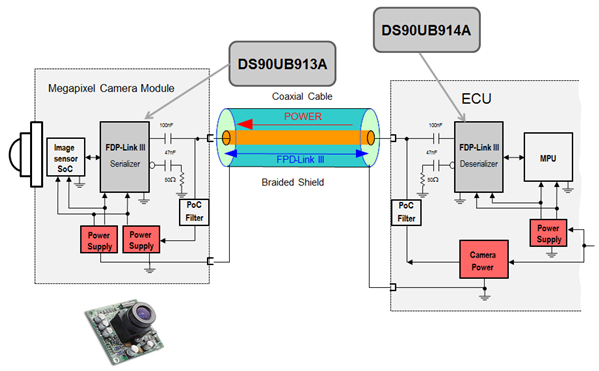SSZTAY7 august 2016 LM53600-Q1 , LP5912-Q1 , TPS61093-Q1
Power over coax (PoC) provides a compact solution for automotive designers looking to reduce vehicle weight as manufacturers add more cameras and other sensors to fulfill automotive safety requirements. However, like any good thing, issues can happen when sending power and forward- and back-channel signals through the same cable. Plus, the car battery used to power the system can create a wide-voltage excursion as low as 3V during cold-crank operation and as high as 42V during clamped load dump or other transients. A well-designed power supply is essential to ensure that important systems such as advanced driver assistance systems (ADASs) operate under all automotive conditions.
Figure 1 shows an example of an ADAS system using the popular Flat Panel Display (FPD) Link III digital video interface. The deserializer sends power and control signals over the coaxial cable, while the serializer sends video signals back through the same cable. The system has four notable power blocks: power for the deserializer, camera power sent from the deserializer side, power for the serializer and power for the camera’s image sensor.
 Figure 1 Megapixel camera system block
diagram
Figure 1 Megapixel camera system block
diagramOne of the biggest challenges in the megapixel camera system is the potential voltage drop across the coaxial cable. To ensure that the drop won’t cause signal-integrity problems, boost the deserializer voltage to at least 9V before transmitting PoC. Once you have transmitted power to the serializer side, it must be regulated back to the operating voltages for the serializer and image sensor.
Let’s break down these blocks. Starting from the serializer side, where size is a main concern (along with noise and the power supply rejection ratio [PSRR]), I recommend using the LM53600-Q1 buck regulator followed by the LP5912-Q1 low-dropout regulator (LDO) for both serializer power and image-sensor power. The LM53600-Q1 has a 3.55V to 36V wide-input voltage range with transients up to 42V, 23µA quiescent current (IQ) and a 3mm-by-3mm package size. I also recommend the LP5912-Q1 for its 75dB at 1kHz PSRR, 12µVRMS output noise, 30µA IQ and 2mm-by-2mm package size. High PSRR and low output noise are essential for camera applications, since supply ripple and noise can directly affect image quality. Both devices require only a few external components for operation, which provides a small total solution size.
On the deserializer side, the power block for the deserializer is similar to the power block for the serializer side. I also suggest using the LM53600-Q1 and LP5912-Q1 to save on bill of materials (BOM) cost. In this situation, the cost savings aren’t necessarily from size, so you could use other solutions. However, those solutions might require more external components, which could increase the overall design cost. To avoid extra components, be sure to check TI.com for other possible solutions that fit your design.
Lastly, the camera power block is responsible for sending power from the deserializer to the serializer over the coax cable. The power coming from this block must be boosted to 9V and combined with the signal path. According to Section 8.5 of the DS90UB91x data sheet, the output differential voltage |VOD| (DOUT+ and DOUT-) is only between 269mV and 412mV. This means that the output of this block must be clean enough to avoid deteriorating the signal-to-noise ratio (SNR). Luckily, the PoC filters – placed to ensure that the serializer and the deserializer are 50Ω impedance matched – contain an inductor that helps block out high-frequency ripple coming from the boost converter. The higher the switching frequency, the greater the attenuation. For this application, I recommend the 1.2MHz switching frequency TPS61093-Q1 for boost regulation. Shown in Figure 2, with a typical value of around 100µH inductor in the PoC filter, the output ripple is attenuated by about -57dB, or about 0.2% of the original ripple voltage coming from the boost converter.
 Figure 2 Ripple attenuation from the
PoC inductor
Figure 2 Ripple attenuation from the
PoC inductorA megapixel camera is one of the many sensors that have become essential in the automotive industry. As more and more sensors are included for safety and comfort, a well-designed system to send power over coax will save cost and size.
Explore our vast portfolio of automotive certified parts.